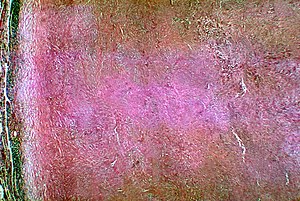Coccidioidomycosis
| Coccidioidomycosis | |
|---|---|
 |
|
| Histopathological changes in a case of coccidioidomycosis of the lung showing a large fibrocaseous nodule. | |
| Classification and external resources | |
| Specialty | Infectious disease |
| ICD-10 | B38 |
| ICD-9-CM | 114 |
| MedlinePlus | 001322 |
| eMedicine | med/103 ped/423 |
| MeSH | D003047 |
Coccidioidomycosis (/kɒkˌsɪdiɔɪdoʊmaɪˈkoʊsɪs/, kok-sid-ee-oy-doh-my-KOH-sis), commonly known as "cocci", "Valley fever", as well as "California fever", "desert rheumatism", and "San Joaquin Valley fever", is a mammalian fungal disease caused by Coccidioides immitis or Coccidioides posadasii. Coccidioidomycosis is endemic in certain parts of Arizona, California, Nevada, New Mexico, Texas, Utah, and northern Mexico.
C. immitis is a dimorphic saprophytic fungus that grows as a mycelium in the soil and produces a spherule form in the host organism. It resides in the soil in certain parts of the southwestern United States, most notably in California and Arizona. It is also commonly found in northern Mexico, and parts of Central and South America.C. immitis is dormant during long dry spells, then develops as a mold with long filaments that break off into airborne spores when it rains. The spores, known as arthroconidia, are swept into the air by disruption of the soil, such as during construction, farming, or an earthquake. Windstorms may also cause epidemics far from endemic areas. In December 1977 a windstorm in an endemic area around Arvin, CA led to several hundred cases, including deaths, in non-endemic areas hundreds of miles away.
...
Wikipedia
